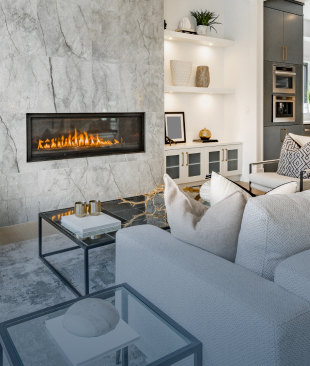Wood-burning Fireplace
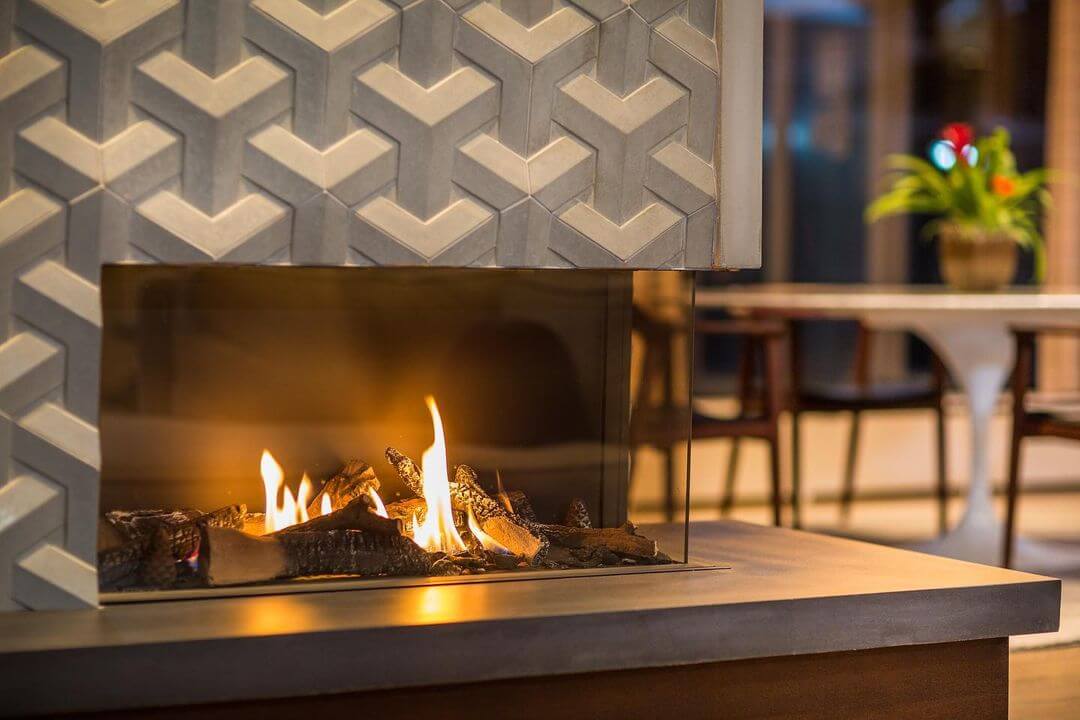
Benefits of wood burning fireplaces
Price: $699 - $2350
- You can enjoy the true ambiance and aroma of all-natural wood by investing in a wood burning fireplace
- Today’s options are packed with lots of features to enhance their simplicity and efficiency
- The wood fireplaces can provide heating during power outages
- Reduces reliance on central heating which leads to cheaper utility bills. It’s a cheaper way to heat the home during the cold winter months since a wood burning fireplace doesn’t consume any electricity, power, or gas.
- Some models can double up as stovetops. You can use them to heat a variety of foods or even warm a kettle.
- Enjoy the aroma of a wood burning fire. Different wood species produce different aromas.
- Wood burning fireplaces produce natural lighting
- Wood burning fireplaces cost less to operate compared to gas fireplaces
Gas Fireplace
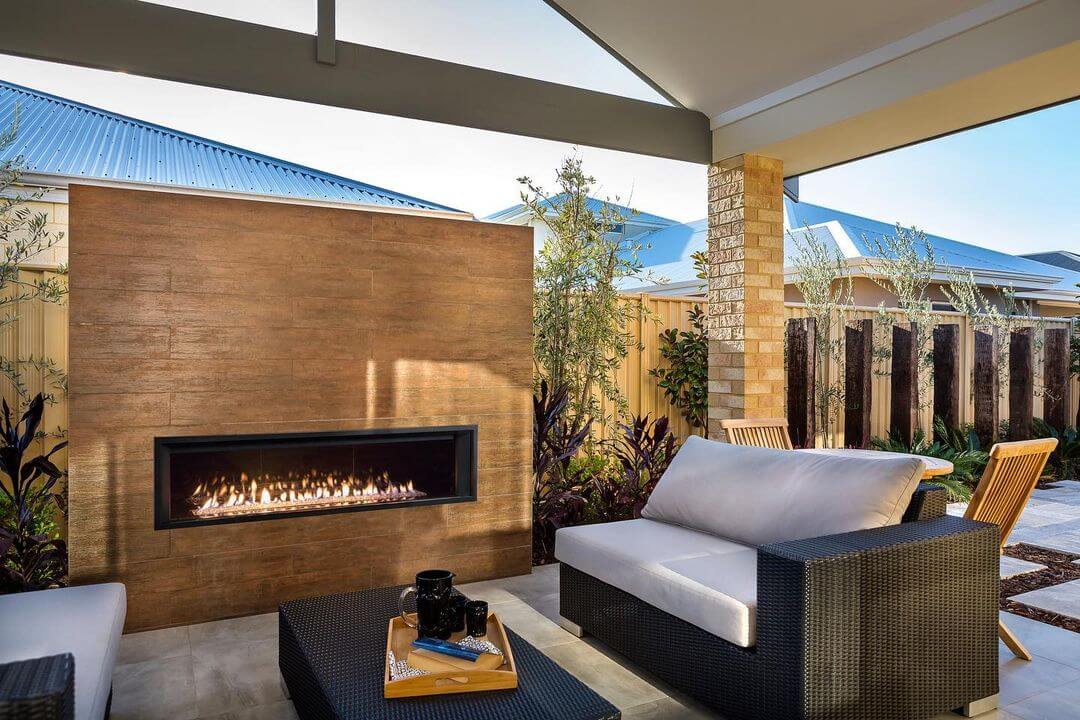
Benefits of gas fireplaces
Price: $3000 - $6000
- Gas fireplaces often come with an on/off switch that makes it extra convenient to operate
- These units are easier to keep clean since there’s no messy ashes, wood chips, and bark that needs thorough cleaning
- There’s no chimney that needs regular cleaning over the years
- All units are properly sealed which enhances safety and reduces the risk of toxic combustion gases spilling into the room
- Electric fireplaces are more environmentally friendly compared to the conventional wood units
Electric Fireplace
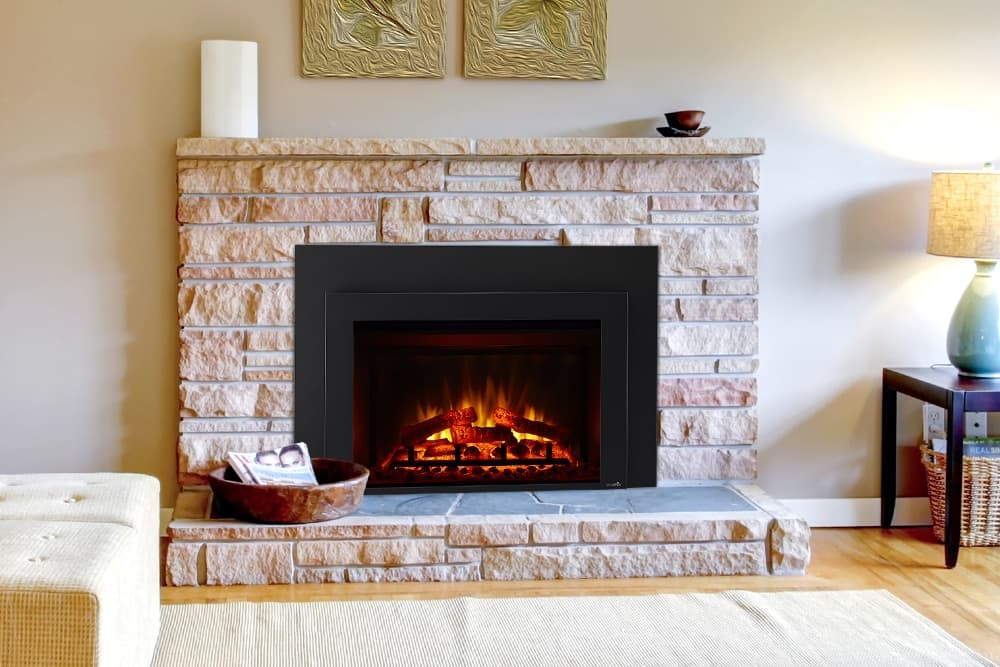
Benefits of electric fireplaces
Price: $1200 - $3000
- They are much safer than traditional wood fireplaces which makes them an excellent option for homes with children and animals
- They are inexpensive to buy, fast and easy to install
- There’s little to no maintenance required for most electric fireplaces
- An electric fireplace can instantly boost the resale value of your home
Identifying the ideal fireplace to install for your home that complements its décor can be tricky business. With options such as electric, gas, and wood fireplaces to choose from, you may easily get overwhelmed. Nothing feels more soothing after a long day than the cosy ambiance in a room with nicely burning wood. The most ideal choice for your home will depend on your budget and needs.
Electrical fireplaces – What they are and how they work
If you’re looking for a fireplace that will give you more flexibility than the wood or gas burning options, consider an electric unit. Electric fireplaces are considered a quick and easy way to get a fireplace running in any home compared to their wood or gas-burning counterparts. They come with a heating element that mimics a traditional wood-burning or gas fireplace. This heating coil warms cool air and forces it out into the room via a fan. Some advanced electrical fireplaces are designed using infrared technology which allows them to heat objects within the room. In all cases, when an electrical fireplace is used, the heat is provided without any mess, fumes, or dangerous gas emissions.
Electrical fireplaces are most ideal for rooms that are about 40 square feet in size. Most models allow the user to adjust the heating elements and flame effects to their liking. You can control the flame and enjoy large or small flames throughout the year. Advanced technology has been used to ensure electric fireplaces can produce a fire that glows exactly the way real firewood or gas burns.
Why are electric fireplaces popular?
- They are much safer than traditional wood fireplaces which makes them an excellent option for homes with children and animals
- They are inexpensive to buy, fast and easy to install
- There’s little to no maintenance required for most electric fireplaces
- An electric fireplace can instantly boost the resale value of your home
However, take note of the following drawbacks of electric fireplaces:
- They don’t produce a real flame
- They don’t heat
- They are less environmentally friendly
- It takes longer to feel the heat produced in an electric fireplace
- An electric fireplace doesn’t require any kind of venting or professional installation
Gas fireplaces
Gas fireplaces are an ideal option in contemporary homes especially those that are not compatible with the traditional wood-burning fireplaces. Most people will go for gas fireplaces to avoid the inefficiency of most traditional wood-burning options. Gas fireplaces are not only considered safe but they’re also energy-efficient and environmentally friendly compared to their wood-burning counterparts. The best part is a unit that runs on gas can be installed in a completely new fireplace or an existing wood-burning fireplace.
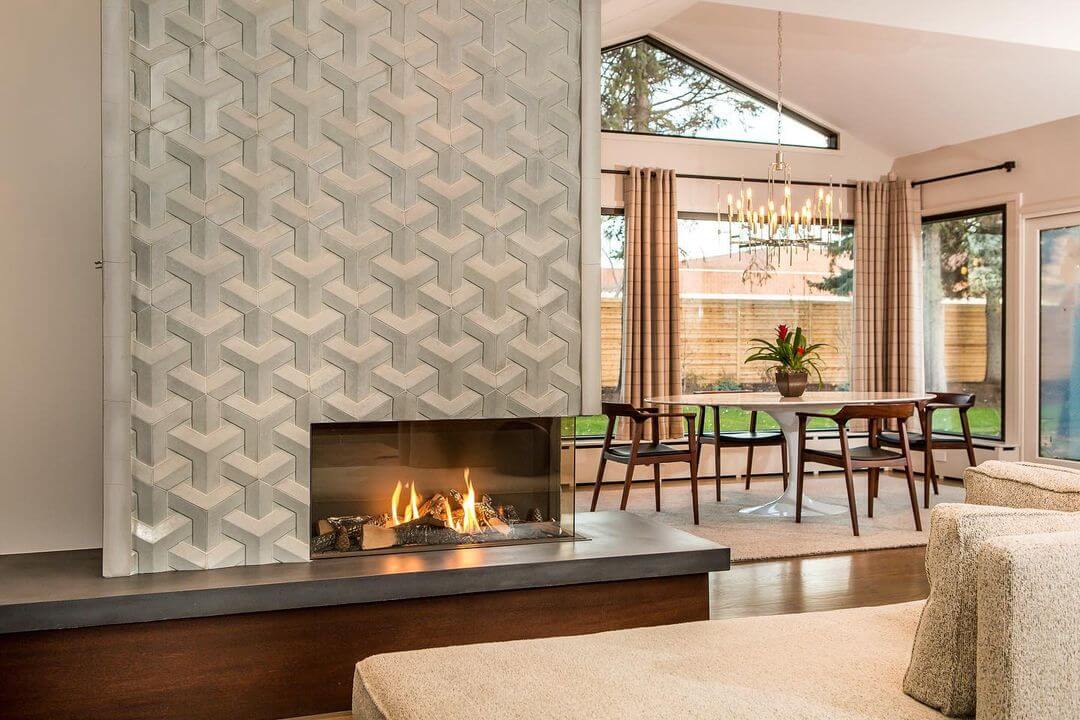
Gone are the days when gas fireplace flames looked “fake” and “uninteresting”. Today’s units have been manufactured to ensure the flames produced are realistic and closely resemble the wood-burning fireplaces. Aesthetic improvements have made these units more appealing to homeowners who are looking for cleaner-burning alternatives.
With gas fireplaces, you need to know what to look for and what to avoid so you can choose a unit that fits your home’s décor and meets your heating needs.
Types of gas fireplaces
There are 3 basic types of gas fireplaces. They include:
- Gas Inserts: They are designed to fit into an existing fireplace. Gas is emitted through a firebox and produces heat. Most people will go for gas inserts because they are user-friendly and very efficient.
- Zero-clearance gas fireplaces: These ones are used in installations where there’s no existing fireplace. They are pre-manufactured fireplaces installed almost directly next to combustible materials such as wood or panelling. The firebox is constructed in such a way that it won’t affect the nearby materials. They don’t need a chimney for venting.
- Freestanding gas fireplaces: They are mostly used to supply heat to different areas in a home. They offer a low maintenance and energy-efficient way to heat a home. The freestanding gas stove can be vented through an existing chimney or out of the wall.
Benefits of gas fireplaces
There are several factors that attract homeowners to gas fireplaces. They include:
- Gas fireplaces often come with an on/off switch that makes it extra convenient to operate
- These units are easier to keep clean since there’s no messy ashes, wood chips, and bark that needs thorough cleaning
- There’s no chimney that needs regular cleaning over the years
- All units are properly sealed which enhances safety and reduces the risk of toxic combustion gases spilling into the room
- Electric fireplaces are more environmentally friendly compared to the conventional wood units
Wood burning fireplaces
If you still enjoy the look of timber and an old-fashioned flame in your home, a wood burning fireplace would be an excellent choice. Some people will still go for the typical all-natural wood-burning stove in their living areas because of its charm and simplicity. Sure, other alternatives like gas are super easy and convenient to operate. You can start an instant fire by simply flicking a switch. It’s a different story when it comes to wood burning fireplaces.

Benefits of wood burning fireplaces
- You can enjoy the true ambiance and aroma of all-natural wood by investing in a wood burning fireplace
- Today’s options are packed with lots of features to enhance their simplicity and efficiency
- The wood fireplaces can provide heating during power outages
- Reduces reliance on central heating which leads to cheaper utility bills. It’s a cheaper way to heat the home during the cold winter months since a wood burning fireplace doesn’t consume any electricity, power, or gas.
- Some models can double up as stovetops. You can use them to heat a variety of foods or even warm a kettle.
- Enjoy the aroma of a wood burning fire. Different wood species produce different aromas.
- Wood burning fireplaces produce natural lighting
- Wood burning fireplaces cost less to operate compared to gas fireplaces
Top considerations when buying a wood burning fireplace
- Some wood burning fireplaces cannot be easily retrofitted into an existing structure. You will need to plan early for the fireplace before it’s installed.
- Wood burning fireplaces do not have the greatest reputation for energy efficiency. The heat generated in a wood burning fireplace escapes through the chimney.
- Indoor air quality may be an issue when you have a wood fireplace. They produce harmful emissions which not only pollute the outdoor air but also greatly undermine the indoor air quality.
How much will you pay for a fireplace?
In addition to the cost of buying a fireplace, you need to consider the cost of professional installation. Labour expenses will vary from one customer to another because some jobs are just more complicated than others. There are even cases where the cost of installation is much higher than the unit itself.
Electric fireplaces cost
The average cost of installing an electric fireplace is usually between $150 and $300. How much you will pay for labour greatly depends on the location of the electrical outlet or junction box and the fireplace. An electric fireplace will cost $1200 to $3000 depending on its style and features.
When it comes to the cost of operating an electric fireplace, expect to spend about 0.3 to 3 cents per hour when running a unit without heat. A unit that produces heat 100% of the time will cost you about 19 cents per hour.
Gas fireplaces cost
Gas fireplaces are usually more expensive than electric options. The most affordable units will start at $2000. The usual range for gas fireplaces is about $3000 to $6000.
The cost of operating a gas fireplace will range between 20 cents to 40 cents per hour. Some models will cost less depending on their BTUs.
When it comes to installation, gas fireplaces will require some venting which must go on the outside wall. The gas line must also be brought to the site which means labour costs must be included. Even if you have an existing gas line, you will need an additional line installed for the gas fireplace. Expect to pay a minimum of $100 to have the propane tank installed.
Wood burning fireplaces cost
Wood burning fireplaces cost between $699 and $2350. With this type of fireplace, you will need a properly functioning chimney. If your existing chimney is faulty or not up to code, it will need to be replaced before the installation process begins. You can expect to pay around $2500 for a new chimney liner. Keep in mind that you will need to set aside some money for routine chimney maintenance. Regular sweeps and inspections are recommended to prevent chimney fires and ensure it remains up to code.
Installation process
The process of installing a fireplace can be as quick as one day or as long as a week. It will depend on the type of fireplace as well as where it’s installed. Keep in mind that a fireplace is designed to burn fuel inside your home. For this reason, it must be installed correctly to prevent safety concerns and guarantee homeowners the highest effectiveness. A poorly installed fireplace can be a serious safety hazard. We recommend having a licensed, certified, and experienced installer who will ensure that the device is not only properly installed but also that the manufacturer’s warranty remains in effect because the installation is done in compliance with building codes.
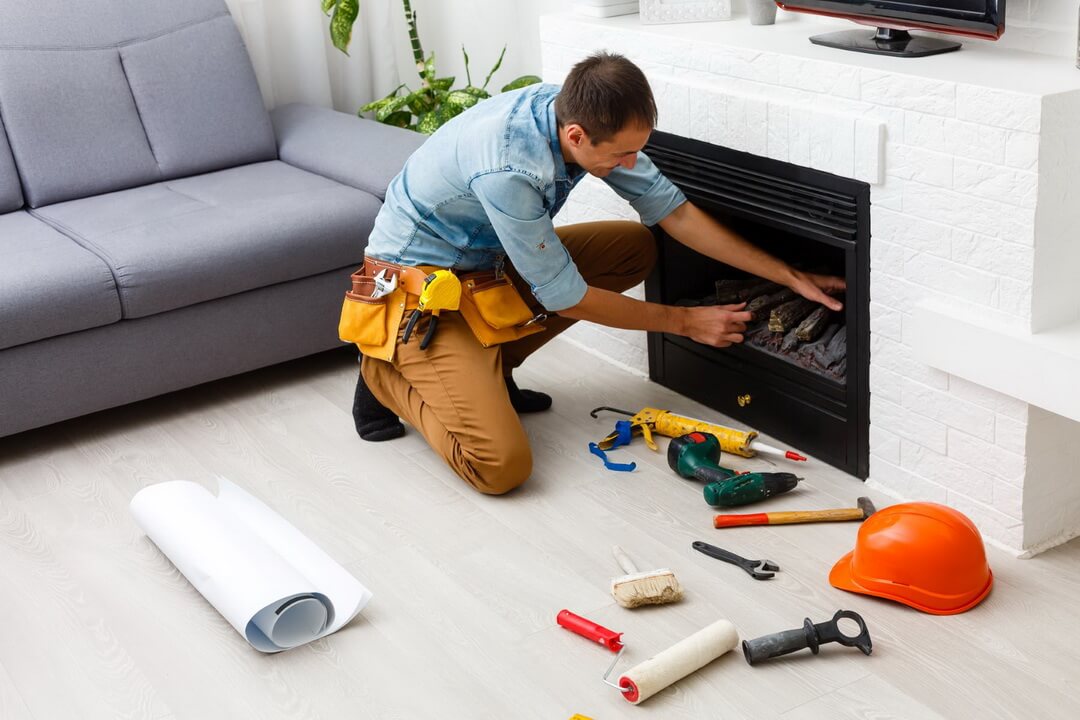
6 things to keep in mind when installing an indoor fireplace
- Pick a model that is suitable for your home: Not all homes can support a wood burning fireplace. With so many options of fireplaces to choose from, it’s important to get the most suitable one for your home. There are strict building codes that may prevent you from getting the model you want. In other cases, your home may require serious reworking in order to support the type of fireplace you want. Consider these factors when choosing a fireplace for your property.
- Think of the bigger picture: Have you considered how the fireplace will fit with the rest of the elements in the room? Have you chosen the type of fireplace screen that’s suitable for your space? With so many style options to choose from, take time to settle on a device that compliments the rest of your space.
- Understand the complexity of installation: The installation process may require some professional masonry. If this is the case, expect to pay more. Understand what the cost implications are and budget for your fireplace accordingly.
- Fireplaces are best as a peripheral source of heat and not to replace your home’s heating units. Use this device to add ambiance and radiant warmth to your home and not to substitute your current heating mechanism. Wood burning fireplaces can cost a lot more to run than the conventional heater.
- Maintenance is key: Regardless of the fireplace you choose, you must be ready to maintain it not only to ensure a longer service life but also to maximize its safety. The unit will need cleaning and some components will require replacement over the years as they become worn out and too dirty to use.
- Never install a fireplace yourself: We recommend having a professional install the fireplace. Fireplaces have safety hazards, which if overlooked, can pose great danger. An individual without any prior fireplace knowledge can make serious mistakes during installation that cost you in the long term.
Heat and energy efficiency
Fireplaces offer different levels of energy efficiency depending on the size and model. Electric fireplaces are said to be 100% efficient since no heat is lost through venting. The heat output of an electric unit will be based on the electric current. For instance, a 120v outlet will produce about 5000BTUs. All the energy is converted into heat. However, the electric fireplace may not warm up a room as effectively as a gas fireplace. That’s why you may notice that the room may remain warm after turning down your thermostat if using a gas unit. An electric fireplace usually requires another heat source running on the side which negates any savings you may have made on energy costs. A gas fireplace on the other hand will use between 7000 and 16000 BTUs. Gas units are said to be 70% to 80% efficient since 20% to 30% of heat is lost through venting.
When it comes to wood burning fireplaces, only 15% of the wood’s energy is converted into useful heat. However, there are some new models that offer up to 75% energy efficiency.

Fireplace Maintenance and Safety
Even though gas fireplaces are considered low maintenance compared to wood burning units, they all require some level of yearly maintenance. Electric fireplaces are the ones that require no regular maintenance because they don’t burn gas or require any venting. We’ll go over some fireplace maintenance and safety tips.
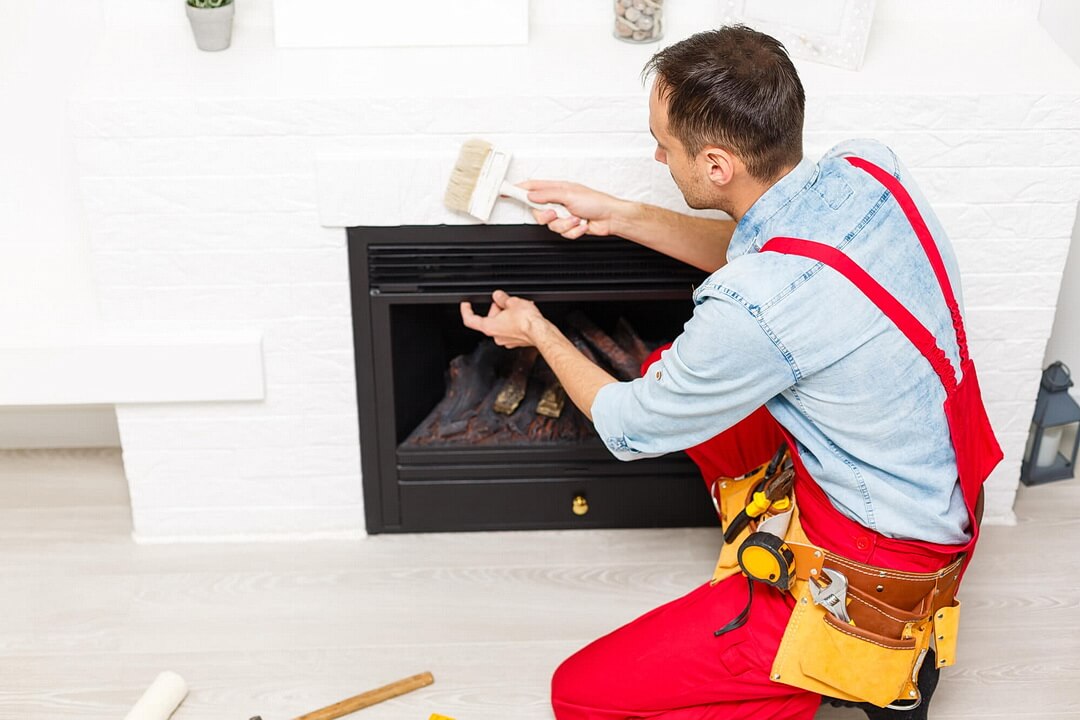
An annual inspection is key: Ensure that the fireplace is inspected annually preferably before the cold weather kicks in. A thorough inspection of the fireplace helps to keep fire hazards at bay and enhance its efficiency by making sure any damage or holes are repaired.
Regular cleanings: Soot on your fireplace can hinder its energy efficiency by up to 50%. Making sure the chimney is kept clean and brushing the inside of the fireplace to remove soot can help improve its efficiency. Follow the manufacturer’s guidelines on cleaning to prevent damaging the fireplace and its components.
Repairs must be done immediately: If there is some form of damage to your fireplace whether cracks or holes, make sure they are fixed immediately. These holes can provide an entryway for snow, rain, wind, or cold air that reduces the fireplace’s efficiency. We recommend capping the chimney to prevent this from happening without losing ventilation.
Swap the logs on your gas fireplace: Consider replacing your existing logs with more energy-efficient gas logs. There are so many new styles coming up in the market and making this simple swap can be a great way to enhance the overall efficiency of your unit.
Consider installing a fireplace insert: If you have a wood burning fireplace and you’re thinking of improving its efficiency, consider installing some inserts. These inserts can drastically enhance the efficiency of your traditional wood burning fireplace.
Choose the right wood: Simply changing the type of wood you use on your fireplace can enhance safety and efficiency. Seasoned (dried) wood is the best option. Make sure you store this wood in a dry place for not less than 6 months. It’s likely to heat more efficiently and prevent the flammable by-products from gathering around your chimney when it burns.
Add tempered glass fireplace doors: These doors are designed to ensure that the fireplace area remains safe especially if you have kids and pets in your home. Tempered glass fireplace doors are also suitable in protecting furniture and floors from sparks which can result in permanent damage.
Ensure your carbon monoxide detectors are installed and properly working: This will ensure that whenever your fireplace is emitting toxic fumes in the atmosphere, the detectors will be triggered.
Ensure the damper is open: Never start a fire unless you’re sure the damper is open. This will prevent smoke from filling the room and resulting in a smoky home.
Remove flammable items near your fireplace: Flammable items that are found in the home such as nail polish remover, aerosol sprays, fire starters, and lighter fluid should be kept far from your unit.
Maintain mild fires: Small fires are the safest. Big fires are riskier as they can fill the area with smoke and damage the chimney. A rule of thumb is to keep big fires out of the home.
Don’t leave a burning fire unattended and make sure the fire is completely extinguished before leaving the house. Make sure your home’s fire extinguishers are well maintained and properly positioned in case of an emergency. Most importantly, know how to use the extinguisher in case something goes wrong.
Questions to ask when choosing a fireplace
Asking the right questions will ensure you get the perfect fireplace for your setting. It’s smart to consider all available options and choose one that fits your décor style, budget, and needs. We’ll go over some 5 important questions to ask yourself before you settle for a fireplace.
- What style of fireplace suits your home? There are so many style options to choose from. Contemporary fireplaces are often sleeker and shinier in design. Decide whether you want your fireplace to be like a piece of art or a functional unit that helps add warmth and comfort to your home.
- What’s the best choice of fuel? You have wood, gas, and electric options to choose from. Educate yourself on their pros and cons so that you can choose one that fits your needs in the long term. Keep in mind that the fuel it burns will determine the ease of operation, maintenance requirements, and initial cost of the unit.
- How much interaction do you want? Some fireplaces require no interaction and have incredibly low maintenance demands. If you’re looking for an easy to operate and maintain -free fireplace, go for gas or electric options. Wood burning fireplaces require a lot more hands-on operation but it all boils down to your personal preferences.
- How much do you want to spend? There are units that are very economical to buy and install. Consider not only the cost of the unit but also the installation and maintenance costs.
- Will it offer you a return on investment? If you want a fireplace that gives you a good return on investment, consider its key features. Fireplaces are great selling points in most homes.
A good fireplace can truly transform the look and feel of any space. We hope this information helps you to start shopping for your ideal unit.
Toronto's Fireplace Store
Book an appointment
- +1 (416) 899-9998
- Unit 2, 535 Millway Avenue, Concord



 Website Design and SEO by dNovo Group | © 2024 All Rights Reserved – The Fireplace Store |
Website Design and SEO by dNovo Group | © 2024 All Rights Reserved – The Fireplace Store | 